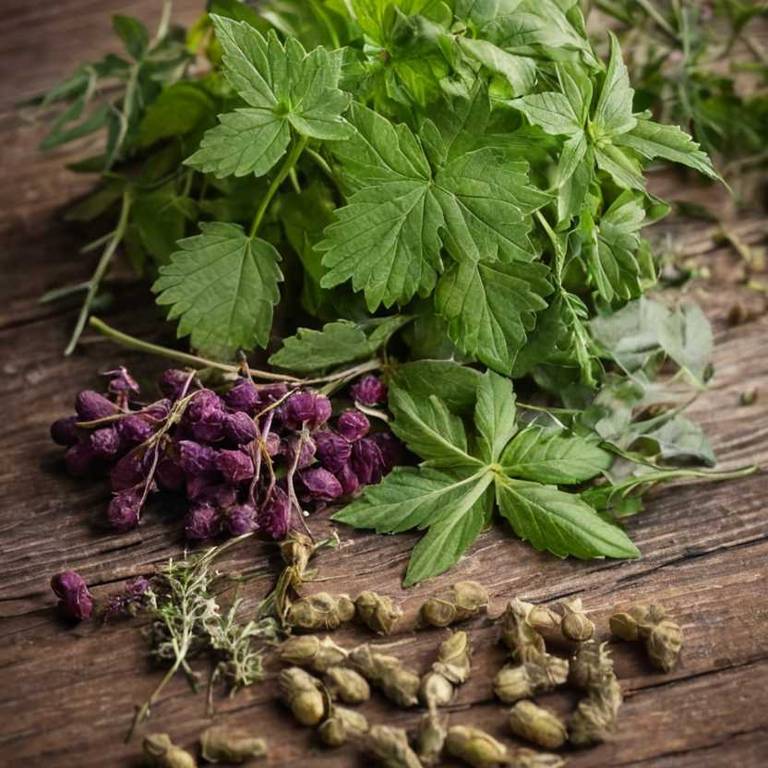By Leen Randell
Updated: Jul 20, 2024
10 Medicinal Constituents Of Vitis Vinifera (Grape)

Vitis vinifera has active constituents such as flavonoids, resveratrol, and phenolic acids, which have potent antioxidant and anti-inflammatory properties.
These constituents contribute to the medicinal properties of grape, including cardiovascular protection, anti-cancer effects, and neuroprotective benefits.
For example, resveratrol has been shown to improve cardiovascular health by lowering blood pressure and reducing inflammation, while flavonoids may help prevent age-related cognitive decline and reduce the risk of certain cancers.
This article explains in details the 10 best active constituents of Vitis vinifera.
1. Quercetin
Vitis vinifera quercetin is a type of flavonoid that can be found in its leaves, seeds, and skins.
This bioactive compound has been extensively studied for its potential health benefits, including anti-inflammatory, antioxidant, and antimicrobial properties. Quercetin has been shown to exhibit neuroprotective effects, improve cardiovascular health, and even have anticancer activity.
Its unique structure allows it to bind to specific receptors in the body, making it a valuable target for therapeutic applications.
2. Resveratrol
Vitis vinifera resveratrol is a polyphenolic compound found in the skin of grapes.
It has gained significant attention due to its potential health benefits, particularly in the prevention and treatment of chronic diseases such as cardiovascular disease, cancer, and neurodegenerative disorders.
Resveratrol exhibits antioxidant, anti-inflammatory, and antiproliferative properties, making it a promising natural compound for therapeutic applications.
3. Anthocyanins
Vitis vinifera anthocyanins is a class of powerful flavonoid pigments responsible for the vibrant red, purple, and blue colors found in many fruits.
These highly concentrated antioxidants are produced within the skin of grapes during ripening, protecting the fruit from excessive sunlight and oxidative stress.
Anthocyanins have been extensively studied for their potential health benefits, including anti-inflammatory, antimicrobial, and cardio-protective properties.
4. Phenolic acids
Vitis vinifera phenolic acids is a class of compounds found in its fruits and seeds.
These acidic molecules are responsible for the antioxidant properties of grapes and wine, playing a crucial role in protecting them from oxidation and spoilage.
Phenolic acids include gallic acid, ellagic acid, and caffeic acid, among others, which also contribute to the color, aroma, and flavor of grape products.
5. Flavonoids
Vitis vinifera flavonoids is a class of polyphenolic compounds found in its skin and seeds.
These compounds have been extensively studied for their potential health benefits, including antioxidant, anti-inflammatory, and antiviral activities. Flavonoids from Vitis vinifera have been shown to improve cardiovascular health by reducing inflammation, improving blood flow, and protecting against oxidative damage.
They also exhibit antimicrobial properties, making them effective in preventing the growth of pathogenic microorganisms.
6. Proanthocyanidins
7. Kaempferol
Vitis vinifera kaempferol is a flavonoid compound found in the leaves and seeds of the grapevine.
It has been extensively studied for its potential health benefits, including antioxidant and anti-inflammatory properties.
Kaempferol has been shown to have protective effects against cardiovascular disease, cancer, and neurodegenerative disorders, making it a promising area of research in the field of nutrition and medicine.
8. Gallic acid
9. Ferulic acid
Vitis vinifera ferulic acid is a type of phenolic compound found in its seeds and skins.
It has been extensively studied for its potential health benefits, including antioxidant, anti-inflammatory, and antimicrobial properties. Ferulic acid has also been shown to have neuroprotective effects and may help protect against certain diseases such as cancer and cardiovascular disease.
Its unique chemical structure allows it to interact with various enzymes and proteins in the body, making it a promising area of research for its potential therapeutic applications.
10. Catechins
Vitis vinifera catechins is a class of polyphenolic compounds found in its seeds, skin, and pulp.
These antioxidants are responsible for the astringent taste and astringent properties of grapes, particularly in red wine production. Catechins have been studied for their potential health benefits, including anti-inflammatory, antimicrobial, and antiviral effects.
They also contribute to the color, aroma, and flavor compounds of grape products.